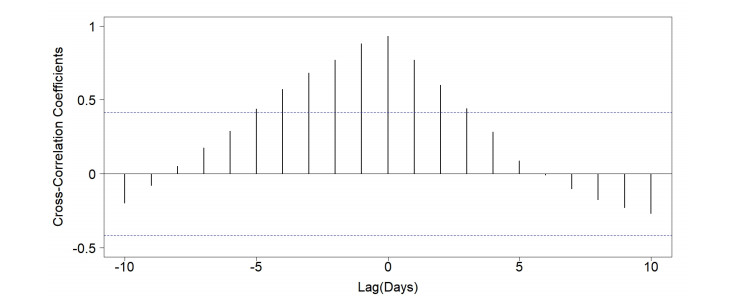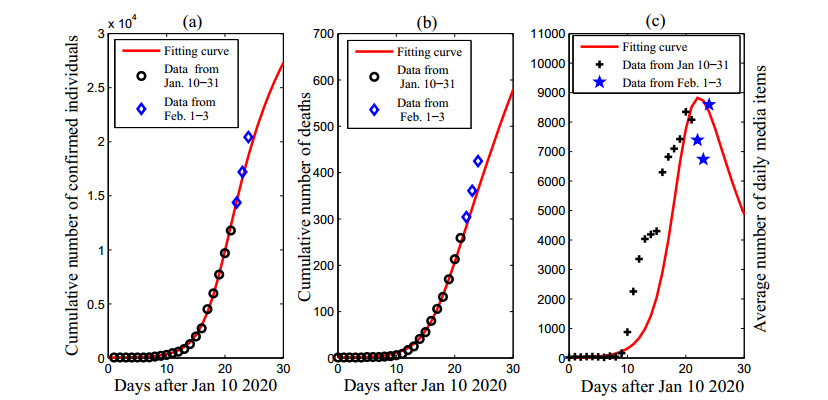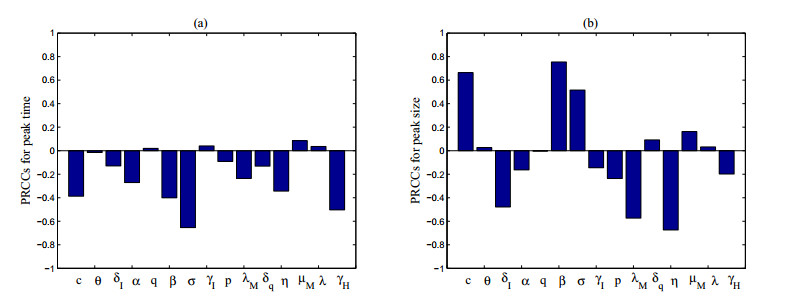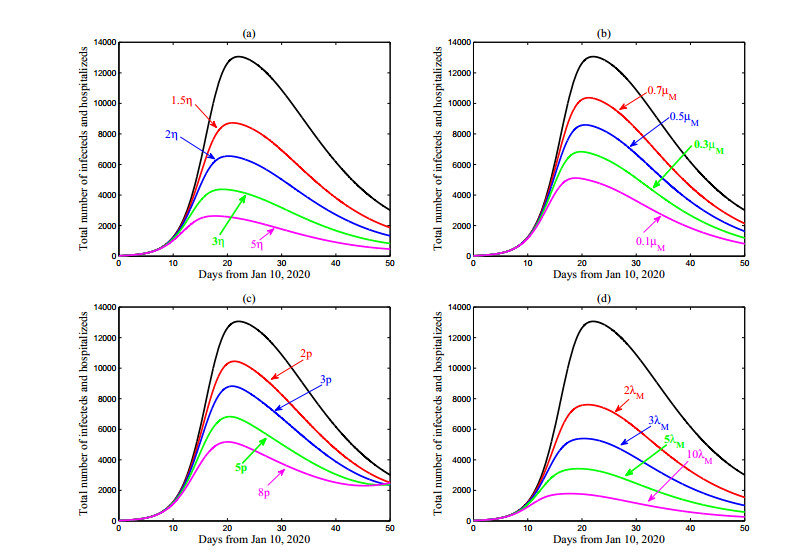| 1.
|
Oberiri Destiny Apuke, Bahiyah Omar,
Fake news and COVID-19: modelling the predictors of fake news sharing among social media users,
2021,
56,
07365853,
101475,
10.1016/j.tele.2020.101475
|
|
| 2.
|
Ali Traoré, Fourtoua Victorien Konané,
Modeling the effects of contact tracing on COVID-19 transmission,
2020,
2020,
1687-1847,
10.1186/s13662-020-02972-8
|
|
| 3.
|
Piotr Staszkiewicz, Iwona Chomiak-Orsa, Igor Staszkiewicz,
Dynamics of the COVID-19 Contagion and Mortality: Country Factors, Social Media, and Market Response Evidence From a Global Panel Analysis,
2020,
8,
2169-3536,
106009,
10.1109/ACCESS.2020.2999614
|
|
| 4.
|
Ayse Konac, Yuksel Barut,
2021,
chapter 26,
9781799868255,
433,
10.4018/978-1-7998-6825-5.ch026
|
|
| 5.
|
Jing Ge, Daihai He, Zhigui Lin, Huaiping Zhu, Zian Zhuang,
Four-tier response system and spatial propagation of COVID-19 in China by a network model,
2020,
330,
00255564,
108484,
10.1016/j.mbs.2020.108484
|
|
| 6.
|
Chandan Maji, Mayer Humi,
Impact of Media-Induced Fear on the Control of COVID-19 Outbreak: A Mathematical Study,
2021,
2021,
1687-9651,
1,
10.1155/2021/2129490
|
|
| 7.
|
Mohammad Hussein, Eman Toraih, Rami Elshazli, Manal Fawzy, August Houghton, Danielle Tatum, Mary Killackey, Emad Kandil, Juan Duchesne,
Meta-analysis on Serial Intervals and Reproductive Rates for SARS-CoV-2,
2021,
273,
0003-4932,
416,
10.1097/SLA.0000000000004400
|
|
| 8.
|
Oberiri Destiny Apuke, Bahiyah Omar,
How do Nigerian newspapers report COVID-19 pandemic? The implication for awareness and prevention,
2020,
35,
0268-1153,
471,
10.1093/her/cyaa031
|
|
| 9.
|
Amparo Güemes, Soumyajit Ray, Khaled Aboumerhi, Michael R. Desjardins, Anton Kvit, Anne E. Corrigan, Brendan Fries, Timothy Shields, Robert D. Stevens, Frank C. Curriero, Ralph Etienne-Cummings,
A syndromic surveillance tool to detect anomalous clusters of COVID-19 symptoms in the United States,
2021,
11,
2045-2322,
10.1038/s41598-021-84145-5
|
|
| 10.
|
Rajanish Kumar Rai, Subhas Khajanchi, Pankaj Kumar Tiwari, Ezio Venturino, Arvind Kumar Misra,
Impact of social media advertisements on the transmission dynamics of COVID-19 pandemic in India,
2021,
1598-5865,
10.1007/s12190-021-01507-y
|
|
| 11.
|
Justin Wong, Liling Chaw, Wee Chian Koh, Mohammad Fathi Alikhan, Sirajul Adli Jamaludin, Wan Wen Patricia Poh, Lin Naing,
Epidemiological Investigation of the First 135 COVID-19 Cases in Brunei: Implications for Surveillance, Control, and Travel Restrictions,
2020,
103,
0002-9637,
1608,
10.4269/ajtmh.20-0771
|
|
| 12.
|
Filip Raciborski, Mateusz Jankowski, Mariusz Gujski, Jarosław Pinkas, Piotr Samel-Kowalik, Artur Zaczyński, Igor Pańkowski, Kamil Rakocy, Waldemar Wierzba,
Prevention of SARS-CoV-2 Infection Among Police Officers in Poland—Implications for Public Health Policies,
2020,
17,
1660-4601,
9072,
10.3390/ijerph17239072
|
|
| 13.
|
Qianqian Cui, Zengyun Hu, Yingke Li, Junmei Han, Zhidong Teng, Jing Qian,
Dynamic variations of the COVID-19 disease at different quarantine strategies in Wuhan and mainland China,
2020,
13,
18760341,
849,
10.1016/j.jiph.2020.05.014
|
|
| 14.
|
Eladio J. Collado-Boira, Estefanía Ruiz-Palomino, Pablo Salas-Media, Ana Folch-Ayora, Maria Muriach, Pablo Baliño,
“The COVID-19 outbreak”—An empirical phenomenological study on perceptions and psychosocial considerations surrounding the immediate incorporation of final-year Spanish nursing and medical students into the health system,
2020,
92,
02606917,
104504,
10.1016/j.nedt.2020.104504
|
|
| 15.
|
V. S. Smirnov, Areg A. Totolian,
Some opportunities for immunotherapy in coronavirus infection,
2020,
10,
2313-7398,
446,
10.15789/2220-7619-SPO-1470
|
|
| 16.
|
L.H.A. Monteiro, V.C. Fanti, A.S. Tessaro,
On the spread of SARS-CoV-2 under quarantine: A study based on probabilistic cellular automaton,
2020,
44,
1476945X,
100879,
10.1016/j.ecocom.2020.100879
|
|
| 17.
|
L.H.A. Monteiro,
An epidemiological model for SARS-CoV-2,
2020,
43,
1476945X,
100836,
10.1016/j.ecocom.2020.100836
|
|
| 18.
|
Guo-Rong Xing, Ming-Tao Li, Li Li, Gui-Quan Sun,
The Impact of Population Migration on the Spread of COVID-19: A Case Study of Guangdong Province and Hunan Province in China,
2020,
8,
2296-424X,
10.3389/fphy.2020.587483
|
|
| 19.
|
Cheng-Cheng Zhu, Jiang Zhu,
Dynamic analysis of a delayed COVID-19 epidemic with home quarantine in temporal-spatial heterogeneous via global exponential attractor method,
2021,
143,
09600779,
110546,
10.1016/j.chaos.2020.110546
|
|
| 20.
|
Md. Arif Billah, Md. Mamun Miah, Md. Nuruzzaman Khan, Maria Elena Flacco,
Reproductive number of coronavirus: A systematic review and meta-analysis based on global level evidence,
2020,
15,
1932-6203,
e0242128,
10.1371/journal.pone.0242128
|
|
| 21.
|
Lin Hu, Lin‐Fei Nie,
Dynamic modeling and analysis of COVID‐19 in different transmission process and control strategies,
2021,
44,
0170-4214,
1409,
10.1002/mma.6839
|
|
| 22.
|
Min Zhou, Piao Long, Nan Kong, Kathryn S. Campy,
Characterizing Wuhan residents’ mask-wearing intention at early stages of the COVID-19 pandemic,
2020,
07383991,
10.1016/j.pec.2020.12.020
|
|
| 23.
|
Seo Yoon Chae, KyoungEun Lee, Hyun Min Lee, Nam Jung, Quang Anh Le, Biseko Juma Mafwele, Tae Ho Lee, Doo Hwan Kim, Jae Woo Lee,
Estimation of Infection Rate and Predictions of Disease Spreading Based on Initial Individuals Infected With COVID-19,
2020,
8,
2296-424X,
10.3389/fphy.2020.00311
|
|
| 24.
|
Prasantha Bharathi Dhandapani, Dumitru Baleanu, Jayakumar Thippan, Vinoth Sivakumar,
On stiff, fuzzy IRD-14 day average transmission model of COVID-19 pandemic disease,
2020,
7,
2375-1495,
208,
10.3934/bioeng.2020018
|
|
| 25.
|
Oberiri Destiny Apuke, Bahiyah Omar,
User motivation in fake news sharing during the COVID-19 pandemic: an application of the uses and gratification theory,
2020,
45,
1468-4527,
220,
10.1108/OIR-03-2020-0116
|
|
| 26.
|
Hong Wu, Zhijian Zhang, Yabo Fang, Shaotang Zhang, Zuo Jiang, Jian Huang, Ping Li,
Containment of rumor spread by selecting immune nodes in social networks,
2021,
18,
1551-0018,
2614,
10.3934/mbe.2021133
|
|
| 27.
|
Akihiro Hisaka, Hideki Yoshioka, Hiroto Hatakeyama, Hiromi Sato, Yoshihiro Onouchi, Naohiko Anzai,
Global Comparison of Changes in the Number of Test-Positive Cases and Deaths by Coronavirus Infection (COVID-19) in the World,
2020,
9,
2077-0383,
1904,
10.3390/jcm9061904
|
|
| 28.
|
Csaba Farkas, David Iclanzan, Boróka Olteán-Péter, Géza Vekov,
Estimation of parameters for a humidity-dependent compartmental model of the COVID-19 outbreak,
2021,
9,
2167-8359,
e10790,
10.7717/peerj.10790
|
|
| 29.
|
Zhiming Li, Zhidong Teng, Changxing Ma,
2019-nCoV Transmission in Hubei Province, China: Stochastic and Deterministic Analyses,
2020,
2020,
1076-2787,
1,
10.1155/2020/9012178
|
|
| 30.
|
Nzaji Michel-Kabamba, Nlandu Ngatu, Ngombe Leon-Kabamba, Astrid Katumbo-Mukemo, Olivier Mukuku, Jean Ngoyi-Mukonkole, Guillaume Ngoie-Mwamba, Elie Kilolo-Ngoie, Ignace Bwana-Kangulu, Dora Kafusthi-Mukemo, Deca Banza-Ndala, Denis Kabila-Mutombo, Marie-Claire Balela-Kabasu, Moise Kanyiki-Katala, Al Syed-Mahfuz, Akitsu Murakami, Kanae Kanda, Yukinori Mashima, Numbi Oscar-Luboya, Tomohiro Hirao,
Occupational COVID-19 Prevention among Congolese Healthcare Workers: Knowledge, Practices, PPE Compliance, and Safety Imperatives,
2020,
6,
2414-6366,
6,
10.3390/tropicalmed6010006
|
|
| 31.
|
Gregory L. Watson, Di Xiong, Lu Zhang, Joseph A. Zoller, John Shamshoian, Phillip Sundin, Teresa Bufford, Anne W. Rimoin, Marc A. Suchard, Christina M. Ramirez, Virginia E. Pitzer,
Pandemic velocity: Forecasting COVID-19 in the US with a machine learning & Bayesian time series compartmental model,
2021,
17,
1553-7358,
e1008837,
10.1371/journal.pcbi.1008837
|
|
| 32.
|
Richard B. Yapi, Clarisse A. Houngbedji, Daniel K.G. N’Guessan, Arlette O. Dindé, Aimé R. Sanhoun, Ariane Amin, Kossia D.T. Gboko, Kathrin Heitz-Tokpa, Gilbert Fokou, Bassirou Bonfoh,
Knowledge, Attitudes, and Practices (KAP) Regarding the COVID-19 Outbreak in Côte d’Ivoire: Understanding the Non-Compliance of Populations with Non-Pharmaceutical Interventions,
2021,
18,
1660-4601,
4757,
10.3390/ijerph18094757
|
|
| 33.
|
Deliana Kostova, Patricia Richter, Gretchen Van Vliet, Michael Mahar, Ronald L. Moolenaar,
The Role of Noncommunicable Diseases in the Pursuit of Global Health Security,
2021,
2326-5094,
10.1089/hs.2020.0121
|
|
| 34.
|
Cheng-Jun Yu, Zi-Xiao Wang, Yue Xu, Ming-Xia Hu, Kai Chen, Gang Qin,
Assessment of basic reproductive number for COVID-19 at global level,
2021,
100,
0025-7974,
e25837,
10.1097/MD.0000000000025837
|
|
| 35.
|
Herman Wasserman, Wallace Chuma, Tanja Bosch, Chikezie E. Uzuegbunam, Rachel Flynn,
South African newspaper coverage of COVID-19: A content analysis,
2021,
13,
2040-199X,
333,
10.1386/jams_00052_1
|
|
| 36.
|
Li-Xiang Feng, Shuang-Lin Jing, Shi-Ke Hu, De-Fen Wang, Hai-Feng Huo,
Modelling the effects of media coverage and quarantine on the COVID-19 infections in the UK,
2020,
17,
1551-0018,
3618,
10.3934/mbe.2020204
|
|
| 37.
|
Ao Li, Yang Wang, Pingping Cong, Xingfu Zou,
Re-examination of the impact of some non-pharmaceutical interventions and media coverage on the COVID-19 outbreak in Wuhan,
2021,
6,
24680427,
975,
10.1016/j.idm.2021.07.001
|
|
| 38.
|
Xia Ma, Xiao-Feng Luo, Li Li, Yong Li, Gui-Quan Sun,
The influence of mask use on the spread of COVID-19 during pandemic in New York City,
2022,
34,
22113797,
105224,
10.1016/j.rinp.2022.105224
|
|
| 39.
|
Haifeng Li, Mo Hai, Wenxun Tang,
Prior Knowledge-Based Causal Inference Algorithms and Their Applications for China COVID-19 Analysis,
2022,
10,
2227-7390,
3568,
10.3390/math10193568
|
|
| 40.
|
James Georgalakis,
Countdown to a Pandemic: BBC News representation of the response to COVID-19 as a global crisis approached,
2021,
1556-5068,
10.2139/ssrn.3931855
|
|
| 41.
|
Brinda Sampat, Sahil Raj,
Fake or real news? Understanding the gratifications and personality traits of individuals sharing fake news on social media platforms,
2022,
74,
2050-3806,
840,
10.1108/AJIM-08-2021-0232
|
|
| 42.
|
Tao Zheng, Yantao Luo, Xinran Zhou, Long Zhang, Zhidong Teng,
Spatial dynamic analysis for COVID-19 epidemic model with diffusion and Beddington-DeAngelis type incidence,
2023,
22,
1534-0392,
365,
10.3934/cpaa.2021154
|
|
| 43.
|
Shaharior Rahman Razu, Nishana Afrin Nishu, Md. Fajlay Rabbi, Ashis Talukder, Paul R. Ward,
Knowledge, Attitudes, and Practices Concerning COVID-19 in Bangladesh: A Qualitative Study of Patients With Chronic Illnesses,
2021,
9,
2296-2565,
10.3389/fpubh.2021.628623
|
|
| 44.
|
Joanna Sooknanan, Terence A. R. Seemungal,
FOMO (fate of online media only) in infectious disease modeling: a review of compartmental models,
2022,
2195-268X,
10.1007/s40435-022-00994-6
|
|
| 45.
|
Bunmi O. Olatunji, Rebecca C. Cox, David A. Cole,
Longitudinal trajectories of coronavirus anxiety and health behavior use before and after the U.S. 2020 presidential election: The effects of political orientation,
2022,
92,
08876185,
102643,
10.1016/j.janxdis.2022.102643
|
|
| 46.
|
Edgar Steiger, Tobias Mussgnug, Lars Eric Kroll, Sungwoo Lim,
Causal graph analysis of COVID-19 observational data in German districts reveals effects of determining factors on reported case numbers,
2021,
16,
1932-6203,
e0237277,
10.1371/journal.pone.0237277
|
|
| 47.
|
Temple Uwalaka,
‘Abba Kyari did not die of Coronavirus’: Social media and fake news during a global pandemic in Nigeria,
2022,
1329-878X,
1329878X2211012,
10.1177/1329878X221101216
|
|
| 48.
|
Medhavi Gupta, Vikash Ranjan Keshri, Pompy Konwar, Katherine L Cox, , and Jagnoor Jagnoor,
Media coverage of COVID-19 health information in India: a content analysis,
2022,
37,
1460-2245,
10.1093/heapro/daab116
|
|
| 49.
|
Yang Liu, Yi Chen, Kefan Xie, Jia Liu,
Effectiveness and policies analysis of pool testing method for COVID-19,
2023,
52,
0368-492X,
64,
10.1108/K-01-2021-0052
|
|
| 50.
|
Omaji Samuel, Akogwu Blessing Omojo, Abdulkarim Musa Onuja, Yunisa Sunday, Prayag Tiwari, Deepak Gupta, Ghulam Hafeez, Adamu Sani Yahaya, Oluwaseun Jumoke Fatoba, Shahab Shamshirband,
IoMT: A COVID-19 Healthcare System Driven by Federated Learning and Blockchain,
2023,
27,
2168-2194,
823,
10.1109/JBHI.2022.3143576
|
|
| 51.
|
Ying-Qi Wang, Qing-Sheng Li, Xin-Qiang Zheng, Jian-Liang Lu, Yue-Rong Liang,
Antiviral Effects of Green Tea EGCG and Its Potential Application against COVID-19,
2021,
26,
1420-3049,
3962,
10.3390/molecules26133962
|
|
| 52.
|
Chao Zuo, Fenping Zhu, Yuting Ling,
Analyzing COVID-19 Vaccination Behavior Using an SEIRM/V Epidemic Model With Awareness Decay,
2022,
10,
2296-2565,
10.3389/fpubh.2022.817749
|
|
| 53.
|
İlkin Esen YILDIRIM, Deniz SEZGİN,
COVID-19 Salgınında Türkiye’de Normalleşme Sürecine Geçiş: Ankara İli Örneğinde Toplumsal Bir Bakış,
2021,
4,
2667-4343,
92,
10.53048/johass.888234
|
|
| 54.
|
Xinghua Chang, Jianrong Wang, Maoxing Liu, Zhen Jin, Dun Han,
Study on an SIHRS Model of COVID-19 Pandemic With Impulse and Time Delay Under Media Coverage,
2021,
9,
2169-3536,
49387,
10.1109/ACCESS.2021.3064632
|
|
| 55.
|
Chentong Li, Huan Lei, Zhanhu Hu, Xinwang Li, Junxiong Liang, Zhenyu Zhong,
2021,
A Stochastic Model with Optimal Control Strategy of the Transmission of Covid-19,
978-1-6654-3531-4,
62,
10.1109/ICESIT53460.2021.9697050
|
|
| 56.
|
Maheswari Rangasamy, Nazek Alessa, Prasantha Bharathi Dhandapani, Karuppusamy Loganathan,
Dynamics of a Novel IVRD Pandemic Model of a Large Population over a Long Time with Efficient Numerical Methods,
2022,
14,
2073-8994,
1919,
10.3390/sym14091919
|
|
| 57.
|
Anuj Kumar Gupta, Manvinder Sharma, Ankit Sharma, Vikas Menon,
A Study on SARS-CoV-2 (COVID-19) and Machine Learning Based Approach to Detect COVID-19 Through X-Ray Images,
2022,
22,
0219-4678,
10.1142/S0219467821400106
|
|
| 58.
|
Jinxing Guan, Yongyue Wei, Yang Zhao, Feng Chen,
Modeling the transmission dynamics of COVID-19 epidemic: a systematic review,
2020,
34,
1674-8301,
422,
10.7555/JBR.34.20200119
|
|
| 59.
|
Gürkan MURATDAĞI, Elif SARICA, Elif KÖSE, Serap UNGAN, Muhammet Raşit AYDIN, Abdülkadir AYDIN, Elif AKAR, Ahmet TÜRKMEN, Erkut ETÇİOĞLU, Emine Melike ARSLAN, Aslıhan ARIKAN, Ahmet ÖKSÜZ, Yıldız BÜYÜKDERELİ ATADAĞ,
The evaluation of the news related to coronavirus in national media before and after the first declared case inTurkey,
2021,
1309-3878,
10.18521/ktd.885006
|
|
| 60.
|
Tridip Sardar, Sk Shahid Nadim, Sourav Rana,
Detection of multiple waves for COVID-19 and its optimal control through media awareness and vaccination: study based on some Indian states,
2023,
111,
0924-090X,
1903,
10.1007/s11071-022-07887-5
|
|
| 61.
|
Yang Deng, Yi Zhao,
Mathematical modeling for COVID-19 with focus on intervention strategies and cost-effectiveness analysis,
2022,
110,
0924-090X,
3893,
10.1007/s11071-022-07777-w
|
|
| 62.
|
Gloria C. Ugwu, Christian S. Ugwuanyi, Eucharia N. Aye, Celestine O. Eze, Nkiru Christiana Ohia, Emmanuel C. Okenyi, Theresa O. Oforka, Charles A. Oraelosi, Obiageli C. Njoku, Victor S. Ezema, Kelechi O. Ifekoya, Chinyere Theresa Nwoga, Alexander Okondugba, Julia Amobi Onumonu, Rosemary Chinyere Ohaneme, Malachy A. Ezeah,
Validation of coronavirus-2019 phobia scale using preschool practitioners in urban and rural communities in Nigeria,
2022,
101,
0025-7974,
e29209,
10.1097/MD.0000000000029209
|
|
| 63.
|
Haiyin Li, Yan Wu, Toshikazu Kuniya,
Dynamics of SCIR Modeling for COVID-19 with Immigration,
2022,
2022,
1099-0526,
1,
10.1155/2022/9182830
|
|
| 64.
|
Ulva Noviana, M. Hasinuddin, M. Suhron, Sumarti Endah,
Exploring Perception and Role of Nurses during COVID-19 Pandemic: Experiences of Frontline Workers in East Java, Indonesia,
2022,
18,
1675-8544,
72,
10.47836/mjmhs.18.6.11
|
|
| 65.
|
Fang Keren, Ahmad Nabeel Siddiquei, Muhammad Azfar Anwar, Fahad Asmi, Qing Ye,
What Explains Natives and Sojourners Preventive Health Behavior in a Pandemic: Role of Media and Scientific Self-Efficacy,
2021,
12,
1664-1078,
10.3389/fpsyg.2021.664399
|
|
| 66.
|
Tingting Ding, Tongqian Zhang,
Asymptotic behavior of the solutions for a stochastic SIRS model with information intervention,
2022,
19,
1551-0018,
6940,
10.3934/mbe.2022327
|
|
| 67.
|
Maheswari Rangasamy, Christophe Chesneau, Carlos Martin-Barreiro, Víctor Leiva,
On a Novel Dynamics of SEIR Epidemic Models with a Potential Application to COVID-19,
2022,
14,
2073-8994,
1436,
10.3390/sym14071436
|
|
| 68.
|
Youming Guo, Tingting Li,
Modeling the transmission of second‐wave COVID‐19 caused by imported cases: A case study,
2022,
45,
0170-4214,
8096,
10.1002/mma.8041
|
|
| 69.
|
Deepika Varshney, Dinesh Kumar Vishwakarma,
Framework for detection of probable clues to predict misleading information proliferated during COVID-19 outbreak,
2023,
35,
0941-0643,
5999,
10.1007/s00521-022-07938-3
|
|
| 70.
|
Jinxing Guan, Yang Zhao, Yongyue Wei, Sipeng Shen, Dongfang You, Ruyang Zhang, Theis Lange, Feng Chen,
Transmission dynamics model and the coronavirus disease 2019 epidemic: applications and challenges,
2022,
2,
2749-9642,
89,
10.1515/mr-2021-0022
|
|
| 71.
|
Ráchael A. Powers, Kacy Bleeker, Crystal Alcalde,
Anti-Asian Hate Crime in U.S. National News: A Content Analysis of Coverage and Narratives from 2010–2021,
2023,
13,
2153-3687,
32,
10.1177/21533687221120949
|
|
| 72.
|
Xiunan Wang, Hao Wang, Pouria Ramazi, Kyeongah Nah, Mark Lewis,
A Hypothesis-Free Bridging of Disease Dynamics and Non-pharmaceutical Policies,
2022,
84,
0092-8240,
10.1007/s11538-022-01012-8
|
|
| 73.
|
Shanlang Lin, Chao Ma, Ruofei Lin,
Research on the Influence of Information Diffusion on the Transmission of the Novel Coronavirus (COVID-19),
2022,
19,
1660-4601,
6801,
10.3390/ijerph19116801
|
|
| 74.
|
Jyu-Lin Chen, Chen-Xi Lin, Mijung Park, Jerry John Nutor, Rosalind de Lisser, Thomas J. Hoffmann, Hannah J. Kim,
Rapid response nursing triage outcomes for COVID-19: factors associated with patient’s participation in triage recommendations,
2023,
23,
1472-6947,
10.1186/s12911-023-02139-x
|
|
| 75.
|
Tangjuan Li, Yanni Xiao,
Complex dynamics of an epidemic model with saturated media coverage and recovery,
2022,
107,
0924-090X,
2995,
10.1007/s11071-021-07096-6
|
|
| 76.
|
Hao Wang, Di Zhu, Shiqi Li, Robert A. Cheke, Sanyi Tang, Weike Zhou,
Home quarantine or centralized quarantine? A mathematical modelling study on the COVID-19 epidemic in Guangzhou in 2021,
2022,
19,
1551-0018,
9060,
10.3934/mbe.2022421
|
|
| 77.
|
Yan Wang, Feng Qing, Haozhan Li, Xuteng Wang,
Timely and effective media coverage's role in the spread of Corona Virus Disease 2019,
2022,
0170-4214,
10.1002/mma.8732
|
|
| 78.
|
Suihong Lan, Jiaxiang Li, Chao Zhao,
2022,
Chapter 18,
978-3-031-06049-6,
241,
10.1007/978-3-031-06050-2_18
|
|
| 79.
|
Michał Górski, Marta Buczkowska, Mateusz Grajek, Jagoda Garbicz, Beata Całyniuk, Kamila Paciorek, Aleksandra Głuszek, Renata Polaniak,
Assessment of the Risk of Depression in Residents Staying at Long-Term Care Institutions in Poland During the COVID-19 Pandemic Depending on the Quality of Cognitive Functioning,
2022,
12,
1664-1078,
10.3389/fpsyg.2021.766675
|
|
| 80.
|
Shuang Zhang, Peng Jing, Daibiao Yuan, Chenlu Yang,
On parents' choice of the school travel mode during the COVID-19 pandemic,
2022,
19,
1551-0018,
9412,
10.3934/mbe.2022438
|
|
| 81.
|
Felix Olajide Talabi, Ikechukwu Peter Ugbor, Moyinoluwa Joseph Talabi, Joel C Ugwuoke, David Oloyede, Ayodeji Boluwatife Aiyesimoju, Amaka B Ikechukwu-Ilomuanya,
Effect of a social media-based counselling intervention in countering fake news on COVID-19 vaccine in Nigeria,
2022,
37,
1460-2245,
10.1093/heapro/daab140
|
|
| 82.
|
Shraddha Ramdas Bandekar, Tanuja Das, Akhil Kumar Srivastav, Anuradha Yadav, Anuj Kumar, Prashant K Srivastava, Mini Ghosh,
Modeling and prediction of the third wave of COVID-19 spread in India,
2022,
10,
2544-7297,
231,
10.1515/cmb-2022-0138
|
|
| 83.
|
Xinghua Chang, Maoxing Liu, Zhen Jin, Jianrong Wang,
Studying on the impact of media coverage on the spread of COVID-19 in Hubei Province, China,
2020,
17,
1551-0018,
3147,
10.3934/mbe.2020178
|
|
| 84.
|
Xinjie Fu, JinRong Wang,
Dynamic stability and optimal control of SISqIqRS epidemic network,
2022,
163,
09600779,
112562,
10.1016/j.chaos.2022.112562
|
|
| 85.
|
Temple Uwalaka, Bigman Nwala, Amadi Confidence Chinedu,
Social media, fake news and fake COVID-19 cures in Nigeria,
2021,
13,
2040-199X,
435,
10.1386/jams_00058_1
|
|
| 86.
|
Yinjiao Gong, Aili Wang, Jin Guo, Stacey R. Smith?, Jorge E. Macias-Diaz,
Modelling the Impact of Media-Induced Social Distancing on the Containment of COVID-19 in Beijing,
2022,
2022,
1607-887X,
1,
10.1155/2022/3954598
|
|
| 87.
|
Sangeeta Saha, Protyusha Dutta, Guruprasad Samanta,
Dynamical behavior of SIRS model incorporating government action and public response in presence of deterministic and fluctuating environments,
2022,
164,
09600779,
112643,
10.1016/j.chaos.2022.112643
|
|
| 88.
|
Biao Tang, Weike Zhou, Xia Wang, Hulin Wu, Yanni Xiao,
Controlling Multiple COVID-19 Epidemic Waves: An Insight from a Multi-scale Model Linking the Behaviour Change Dynamics to the Disease Transmission Dynamics,
2022,
84,
0092-8240,
10.1007/s11538-022-01061-z
|
|
| 89.
|
Tangjuan Li, Yanni Xiao,
Linking the disease transmission to information dissemination dynamics: An insight from a multi-scale model study,
2021,
526,
00225193,
110796,
10.1016/j.jtbi.2021.110796
|
|
| 90.
|
Mengyao Ren, Sangwon Park, Yang Xu, Xiao Huang, Lei Zou, Man Sing Wong, Sun-Young Koh,
Impact of the COVID-19 pandemic on travel behavior: A case study of domestic inbound travelers in Jeju, Korea,
2022,
92,
02615177,
104533,
10.1016/j.tourman.2022.104533
|
|
| 91.
|
Qing Ye, Rongting Zhou, Fahad Asmi,
Evaluating the Impact of the Pandemic Crisis on the Aviation Industry,
2022,
0361-1981,
036119812211257,
10.1177/03611981221125741
|
|
| 92.
|
Glenn Marion, Liza Hadley, Valerie Isham, Denis Mollison, Jasmina Panovska-Griffiths, Lorenzo Pellis, Gianpaolo Scalia Tomba, Francesca Scarabel, Ben Swallow, Pieter Trapman, Daniel Villela,
Modelling: Understanding pandemics and how to control them,
2022,
39,
17554365,
100588,
10.1016/j.epidem.2022.100588
|
|
| 93.
|
Qiaojuan Jia, Yafei Lou, Feilong Rong, Shuai Zhang, Minghua Wang, Linghao He, Zhihong Zhang, Miao Du,
Silver nanoparticle embedded polymer–zirconium-based metal–organic framework (polyUiO-66) for electrochemical biosensors of respiratory viruses,
2021,
9,
2050-7526,
14190,
10.1039/D1TC03100G
|
|
| 94.
|
Asma Alwreikat,
Sharing of Misinformation during COVID-19 Pandemic: Applying the Theory of Planned Behavior with the Integration of Perceived Severity,
2022,
41,
0194-262X,
133,
10.1080/0194262X.2021.1960241
|
|
| 95.
|
Seon-Woo Kim, Martina Santia, Raymond J. Pingree, Ayla Oden, Kirill Bryanov, Jessica Wyers, Natalie J. Shook,
The curve not taken: Effects of COVID-19 international comparison news,
2022,
17,
1932-6203,
e0271041,
10.1371/journal.pone.0271041
|
|
| 96.
|
Ousmane Koutou, Abou Bakari Diabaté, Boureima Sangaré,
Mathematical analysis of the impact of the media coverage in mitigating the outbreak of COVID-19,
2023,
205,
03784754,
600,
10.1016/j.matcom.2022.10.017
|
|
| 97.
|
Jin Guo, Aili Wang, Weike Zhou, Yinjiao Gong, Stacey R. Smith?,
Discrete epidemic modelling of COVID-19 transmission in Shaanxi Province with media reporting and imported cases,
2021,
19,
1551-0018,
1388,
10.3934/mbe.2022064
|
|
| 98.
|
Suleyman Utku UZUN, Ozgur SEVINC, Ahmet ERGIN,
Prevalence of correct face mask usage among general public during COVID-19 pandemic in Denizli, Turkey,
2022,
1019-1941,
10.5472/marumj.1191644
|
|
| 99.
|
Olusegun Emmanuel Akinwale, Uchechi C. Onokala,
2022,
978-1-80117-903-4,
53,
10.1108/978-1-80117-902-720221005
|
|
| 100.
|
Juan Mejía-Trejo, Ismael Loza-Vega,
Social Media Information Literacy vs. Fake News: Probing the Business Decisions under COVID-19 times as Innovation skills with fsQCA,
2021,
1,
27,
10.55965/setp.1.02.a2
|
|
| 101.
|
Ishita Vohra, Meher Shashwat Nigam, Aryan Sakaria, Amey Kudari, Nimmi Rangaswamy,
2022,
Is Twitter Enough? Investigating Situational Awareness in Social and Print Media during the Second COVID-19 Wave in India,
978-1-6654-5661-6,
339,
10.1109/ASONAM55673.2022.10068667
|
|
| 102.
|
Himanshu Grover,
Public Risk Perception of Covid Transmission and Support for Smart Growth Policies in Seattle Metro Region,
2022,
1556-5068,
10.2139/ssrn.4122786
|
|
| 103.
|
Elena E. Popadyuk, Tatyana E. Sizikova, Aleksey L. Khmelev, Mikhail A. Timofeev, Vitaliy N. Lebedev, Sergey V. Borisevich,
The use of immunoglobulins and monoclonal antibodies against COVID-19,
2024,
69,
2411-2097,
119,
10.36233/0507-4088-225
|
|
| 104.
|
S. Sankaranarayanan,
An approach to statistical analysis-using the average transmission model of Covid 19,
2020,
8,
23193786,
2158,
10.26637/MJM0804/0141
|
|
| 105.
|
Corlia Meyer, François van Schalkwyk,
Framing Covid-19 in the South African News Media: An Analysis of 22 Months of Reporting,
2024,
25,
1461-670X,
480,
10.1080/1461670X.2023.2232473
|
|
| 106.
|
Anna D. Fome, Herieth Rwezaura, Mamadou L. Diagne, Shannon Collinson, Jean M. Tchuenche,
A deterministic Susceptible–Infected–Recovered model for studying the impact of media on epidemic dynamics,
2023,
3,
27724425,
100189,
10.1016/j.health.2023.100189
|
|
| 107.
|
Shimli Dutta, Protyusha Dutta, Guruprasad Samanta,
Modelling disease transmission through asymptomatic carriers: a societal and environmental perspective,
2024,
12,
2195-268X,
3100,
10.1007/s40435-024-01387-7
|
|
| 108.
|
Ann Osi, Navid Ghaffarzadegan, Claudio José Struchiner,
Parameter estimation in behavioral epidemic models with endogenous societal risk-response,
2024,
20,
1553-7358,
e1011992,
10.1371/journal.pcbi.1011992
|
|
| 109.
|
Aliasghar Kheirkhah Vakiabad, Ehsan Movahed, Fereshte Gheybi, Fatemeh Kave Farsani, Fatemeh Rigabadi,
Is Strengths, Weaknesses, Opportunities, and Threats Analysis Effective in Preventing and Controlling Coronavirus Disease-19? A qualitative study,
2024,
13,
2645-6109,
131,
10.34172/jqr.2024.19
|
|
| 110.
|
Yunbo Tu, Xinzhu Meng,
A reaction–diffusion epidemic model with virus mutation and media coverage: Theoretical analysis and numerical simulation,
2023,
214,
03784754,
28,
10.1016/j.matcom.2023.06.023
|
|
| 111.
|
Xueli Wang, Suxia Zhang,
Coupling media coverage and susceptibility for modeling epidemic dynamics: An application to COVID-19,
2024,
217,
03784754,
374,
10.1016/j.matcom.2023.10.026
|
|
| 112.
|
Rebecca E. Fuoco, Carol F. Kwiatkowski, Linda S. Birnbaum, Arlene Blum,
Effective communications strategies to increase the impact of environmental health research,
2023,
22,
1476-069X,
10.1186/s12940-023-00997-6
|
|
| 113.
|
秀 秦,
Dynamic Analysis of SEIRS-M Epidemic Mod-el with Media Effect Delay,
2023,
12,
2324-7991,
4338,
10.12677/AAM.2023.1210427
|
|
| 114.
|
Jacques Demongeot, Pierre Magal,
Data-driven mathematical modeling approaches for COVID-19: A survey,
2024,
50,
15710645,
166,
10.1016/j.plrev.2024.08.004
|
|
| 115.
|
Darla Spence Coffey, Deana F. Morrow,
2024,
Chapter 12,
978-3-031-66558-5,
159,
10.1007/978-3-031-66559-2_12
|
|
| 116.
|
Weiyuan Ma, Nuri Ma, Changping Dai, YangQuan Chen, Xinwei Wang,
Fractional modeling and optimal control strategies for mutated COVID‐19 pandemic,
2023,
0170-4214,
10.1002/mma.9313
|
|
| 117.
|
Kangguo Li, Jiayi Wang, Jiayuan Xie, Jia Rui, Buasiyamu Abudunaibi, Hongjie Wei, Hong Liu, Shuo Zhang, Qun Li, Yan Niu, Tianmu Chen,
Advancements in Defining and Estimating the Reproduction Number in Infectious Disease Epidemiology,
2023,
5,
2097-3101,
829,
10.46234/ccdcw2023.158
|
|
| 118.
|
Lamia Alyami, Saptarshi Das, Stuart Townley, Charin Modchang,
Bayesian model selection for COVID-19 pandemic state estimation using extended Kalman filters: Case study for Saudi Arabia,
2024,
4,
2767-3375,
e0003467,
10.1371/journal.pgph.0003467
|
|
| 119.
|
Makayla Preston, Alexandria Carter, Eric Numfor,
Modeling the Effects of Media Awareness on SARS-CoV-2 Transmission in Georgia,
2024,
10,
2349-5103,
10.1007/s40819-024-01759-9
|
|
| 120.
|
Oberiri Destiny Apuke, Bahiyah Omar,
Television News Coverage of COVID-19 Pandemic in Nigeria: Missed Opportunities to Promote Health Due to Ownership and Politics,
2021,
11,
2158-2440,
10.1177/21582440211032675
|
|
| 121.
|
Sonu Lamba, Prashant K. Srivastava,
Cost-effective optimal control analysis of a COVID-19 transmission model incorporating community awareness and waning immunity,
2023,
11,
2544-7297,
10.1515/cmb-2023-0154
|
|
| 122.
|
Arpita Devi, Praveen Kumar Gupta,
Impact of media information and reinfection in a COVID-19 dynamical model: emergence of periodic orbits through Hopf bifurcation,
2024,
99,
0031-8949,
075207,
10.1088/1402-4896/ad4f2e
|
|
| 123.
|
Verónica Israel-Turim, Valentina Laferrara, Ana Regina Rego, Josep Lluís Micó-Sanz,
Misinformation about the COVID-19 Vaccine in Online Catholic Media,
2023,
11,
2076-393X,
1054,
10.3390/vaccines11061054
|
|
| 124.
|
Dandan Sun, Wan-Tong Li, Ming-Zhen Xin,
Dynamics of an age-structured SIS epidemic model with local dispersal and general incidence functions,
2025,
140,
10075704,
108364,
10.1016/j.cnsns.2024.108364
|
|
| 125.
|
Naba Kumar Goswami, Samson Olaniyi, Sulaimon F. Abimbade, Furaha M. Chuma,
A mathematical model for investigating the effect of media awareness programs on the spread of COVID-19 with optimal control,
2024,
5,
27724425,
100300,
10.1016/j.health.2024.100300
|
|
| 126.
|
Ruijie Shu, Hua Xia, Oberiri Destiny Apuke,
The Mechanism Through Which Corporate Social Responsibility (CSR) Affects Customer Patronage of Manufacturing Companies: Modeling the Mediating Role of Corporate Reputation and the Moderating Role of Customer Awareness of CSR Activities,
2024,
14,
2158-2440,
10.1177/21582440241305320
|
|
| 127.
|
Shardul Shankar, Vijayshri Tewari, Shashwat Shankar,
Measuring Emotional Wellbeing and Emotional Contagion Through Sentiments and Emotions Evoked by Social Media for COVID-19,
2024,
14,
2158-2440,
10.1177/21582440241285771
|
|
| 128.
|
Leah LeJeune, Navid Ghaffarzadegan, Lauren M. Childs, Omar Saucedo,
Formulating human risk response in epidemic models: Exogenous vs endogenous approaches,
2025,
03772217,
10.1016/j.ejor.2025.01.004
|
|
| 129.
|
Guowei Sun, Ali Mai, Zhen Jin,
Modeling precaution, immunity loss and dispersal on disease dynamics: a two-patch SIRS model,
2025,
2025,
2731-4235,
10.1186/s13662-024-03862-z
|
|
| 130.
|
Fahad Al Basir, Kottakkaran Sooppy Nisar, Ibraheem M. Alsulami, Amar Nath Chatterjee,
Dynamics and optimal control of an extended SIQR model with protected human class and public awareness,
2025,
140,
2190-5444,
10.1140/epjp/s13360-025-06108-3
|
|
| 131.
|
Xiaojun Ding, Bingxing Shang, Caifeng Xie, Jiayi Xin, Feng Yu,
Artificial intelligence in the COVID-19 pandemic: balancing benefits and ethical challenges in China’s response,
2025,
12,
2662-9992,
10.1057/s41599-025-04564-x
|
|
| 132.
|
Arif Satriantoro, Mohamad Saifudin Mohamad Saleh,
A content analysis of COVID-19 news coverage of
The Jakarta Post
,
The Star
, and
Bangkok Post
,
2025,
0739-5329,
10.1177/30497841251325811
|
|
| 133.
|
Vasiliy Osipov, Marina Osipova, Sergey Kuleshov, Alexandra Zaytseva, Aleksey Aksenov,
Epidemiological Informing of the Population in Cities: Models and Their Application,
2022,
16,
2500-2597,
80,
10.17323/2500-2597.2022.2.80.89
|
|
| 134.
|
Xinghua Chang, Jianrong Wang, Maoxing Liu, Xue Yan,
An SIS infectious disease model with nonlinear incidence and disease awareness on complex networks,
2025,
196,
09600779,
116349,
10.1016/j.chaos.2025.116349
|
|
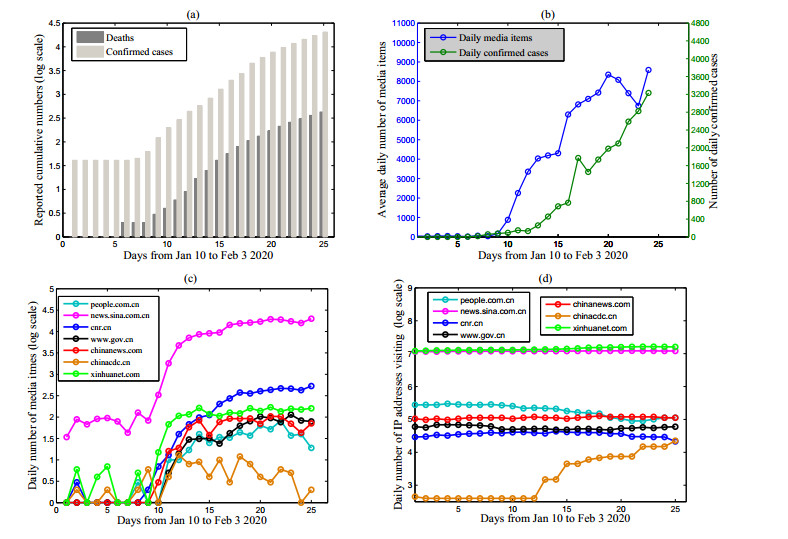









 DownLoad:
DownLoad:
